MNG932002 Case Study: Analyzing Netflix's Win Over Blockbuster Video
VerifiedAdded on 2023/06/12
|14
|4039
|234
Case Study
AI Summary
This case study examines the strategic battle between Netflix and Blockbuster, detailing how Netflix, founded in the late 1990s, disrupted Blockbuster's dominance in the home video rental market. Blockbuster, initially a market leader with numerous brick-and-mortar stores, failed to adapt to changing consumer preferences and emerging technologies. Netflix introduced a subscription-based DVD-by-mail service, eliminating late fees and enhancing customer convenience. As internet technology advanced, Netflix transitioned to streaming media, further solidifying its competitive advantage. Blockbuster's hesitation to embrace new business models, coupled with its reliance on late fees for revenue, led to its eventual bankruptcy. Netflix's strategic focus on customer satisfaction, technological innovation, and convenient pricing models enabled it to capture the market and become the leading online video streaming provider. The case study also considers whether Netflix can maintain its dominance in the face of evolving competition and technological advancements.

Running head: CASE STUDY 1
Case Study
Student’s Name
Institutional Affiliation
Date
Case Study
Student’s Name
Institutional Affiliation
Date
Paraphrase This Document
Need a fresh take? Get an instant paraphrase of this document with our AI Paraphraser
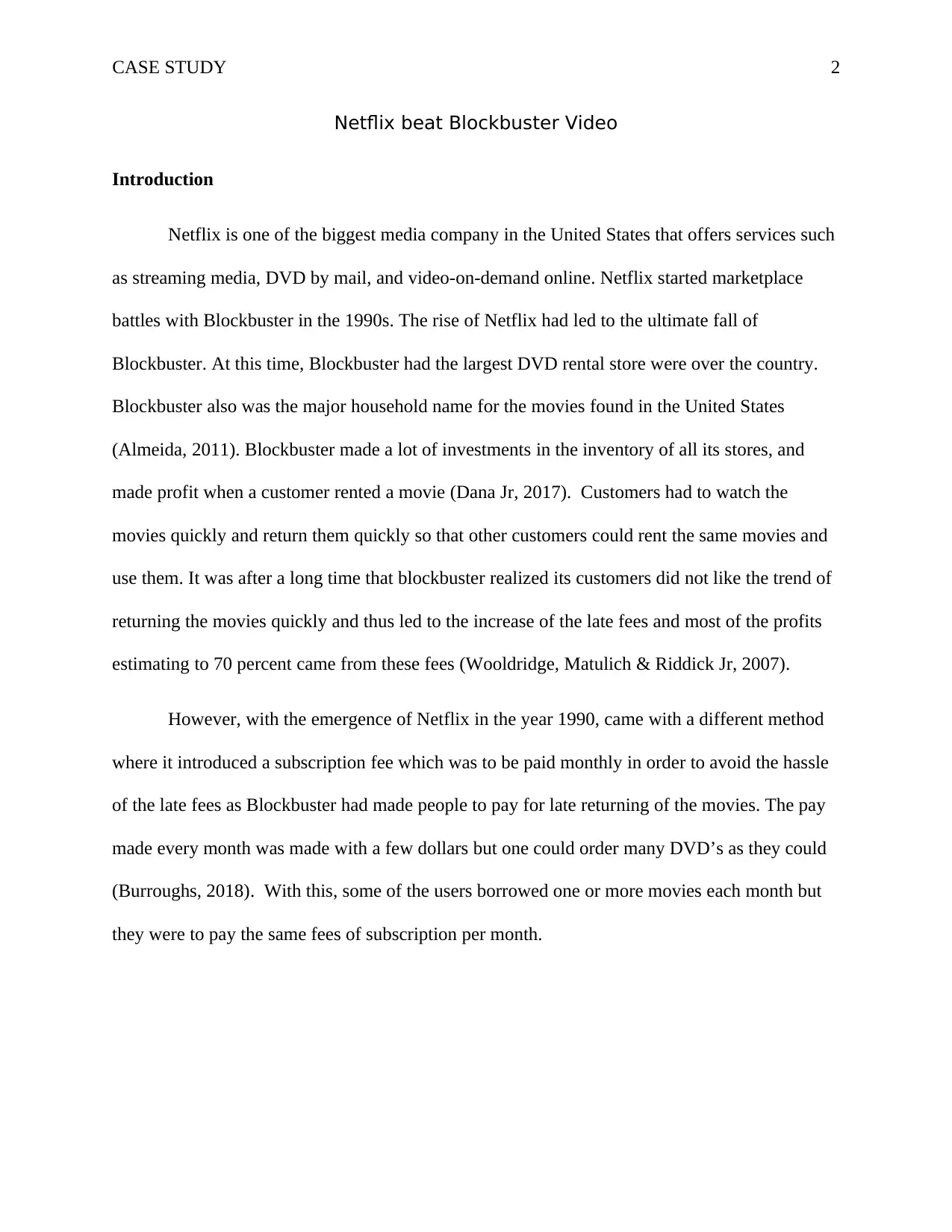
CASE STUDY 2
Netflix beat Blockbuster Video
Introduction
Netflix is one of the biggest media company in the United States that offers services such
as streaming media, DVD by mail, and video-on-demand online. Netflix started marketplace
battles with Blockbuster in the 1990s. The rise of Netflix had led to the ultimate fall of
Blockbuster. At this time, Blockbuster had the largest DVD rental store were over the country.
Blockbuster also was the major household name for the movies found in the United States
(Almeida, 2011). Blockbuster made a lot of investments in the inventory of all its stores, and
made profit when a customer rented a movie (Dana Jr, 2017). Customers had to watch the
movies quickly and return them quickly so that other customers could rent the same movies and
use them. It was after a long time that blockbuster realized its customers did not like the trend of
returning the movies quickly and thus led to the increase of the late fees and most of the profits
estimating to 70 percent came from these fees (Wooldridge, Matulich & Riddick Jr, 2007).
However, with the emergence of Netflix in the year 1990, came with a different method
where it introduced a subscription fee which was to be paid monthly in order to avoid the hassle
of the late fees as Blockbuster had made people to pay for late returning of the movies. The pay
made every month was made with a few dollars but one could order many DVD’s as they could
(Burroughs, 2018). With this, some of the users borrowed one or more movies each month but
they were to pay the same fees of subscription per month.
Netflix beat Blockbuster Video
Introduction
Netflix is one of the biggest media company in the United States that offers services such
as streaming media, DVD by mail, and video-on-demand online. Netflix started marketplace
battles with Blockbuster in the 1990s. The rise of Netflix had led to the ultimate fall of
Blockbuster. At this time, Blockbuster had the largest DVD rental store were over the country.
Blockbuster also was the major household name for the movies found in the United States
(Almeida, 2011). Blockbuster made a lot of investments in the inventory of all its stores, and
made profit when a customer rented a movie (Dana Jr, 2017). Customers had to watch the
movies quickly and return them quickly so that other customers could rent the same movies and
use them. It was after a long time that blockbuster realized its customers did not like the trend of
returning the movies quickly and thus led to the increase of the late fees and most of the profits
estimating to 70 percent came from these fees (Wooldridge, Matulich & Riddick Jr, 2007).
However, with the emergence of Netflix in the year 1990, came with a different method
where it introduced a subscription fee which was to be paid monthly in order to avoid the hassle
of the late fees as Blockbuster had made people to pay for late returning of the movies. The pay
made every month was made with a few dollars but one could order many DVD’s as they could
(Burroughs, 2018). With this, some of the users borrowed one or more movies each month but
they were to pay the same fees of subscription per month.
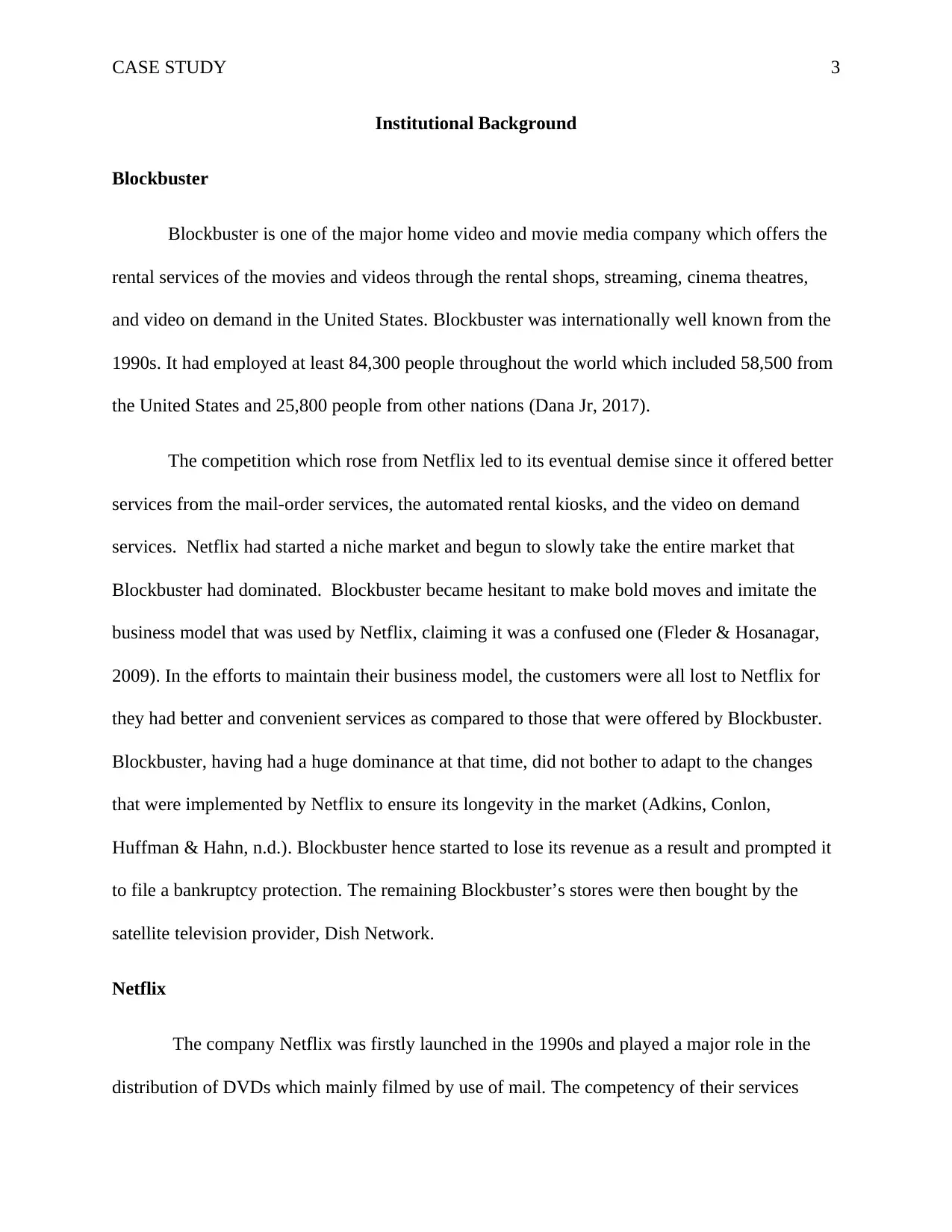
CASE STUDY 3
Institutional Background
Blockbuster
Blockbuster is one of the major home video and movie media company which offers the
rental services of the movies and videos through the rental shops, streaming, cinema theatres,
and video on demand in the United States. Blockbuster was internationally well known from the
1990s. It had employed at least 84,300 people throughout the world which included 58,500 from
the United States and 25,800 people from other nations (Dana Jr, 2017).
The competition which rose from Netflix led to its eventual demise since it offered better
services from the mail-order services, the automated rental kiosks, and the video on demand
services. Netflix had started a niche market and begun to slowly take the entire market that
Blockbuster had dominated. Blockbuster became hesitant to make bold moves and imitate the
business model that was used by Netflix, claiming it was a confused one (Fleder & Hosanagar,
2009). In the efforts to maintain their business model, the customers were all lost to Netflix for
they had better and convenient services as compared to those that were offered by Blockbuster.
Blockbuster, having had a huge dominance at that time, did not bother to adapt to the changes
that were implemented by Netflix to ensure its longevity in the market (Adkins, Conlon,
Huffman & Hahn, n.d.). Blockbuster hence started to lose its revenue as a result and prompted it
to file a bankruptcy protection. The remaining Blockbuster’s stores were then bought by the
satellite television provider, Dish Network.
Netflix
The company Netflix was firstly launched in the 1990s and played a major role in the
distribution of DVDs which mainly filmed by use of mail. The competency of their services
Institutional Background
Blockbuster
Blockbuster is one of the major home video and movie media company which offers the
rental services of the movies and videos through the rental shops, streaming, cinema theatres,
and video on demand in the United States. Blockbuster was internationally well known from the
1990s. It had employed at least 84,300 people throughout the world which included 58,500 from
the United States and 25,800 people from other nations (Dana Jr, 2017).
The competition which rose from Netflix led to its eventual demise since it offered better
services from the mail-order services, the automated rental kiosks, and the video on demand
services. Netflix had started a niche market and begun to slowly take the entire market that
Blockbuster had dominated. Blockbuster became hesitant to make bold moves and imitate the
business model that was used by Netflix, claiming it was a confused one (Fleder & Hosanagar,
2009). In the efforts to maintain their business model, the customers were all lost to Netflix for
they had better and convenient services as compared to those that were offered by Blockbuster.
Blockbuster, having had a huge dominance at that time, did not bother to adapt to the changes
that were implemented by Netflix to ensure its longevity in the market (Adkins, Conlon,
Huffman & Hahn, n.d.). Blockbuster hence started to lose its revenue as a result and prompted it
to file a bankruptcy protection. The remaining Blockbuster’s stores were then bought by the
satellite television provider, Dish Network.
Netflix
The company Netflix was firstly launched in the 1990s and played a major role in the
distribution of DVDs which mainly filmed by use of mail. The competency of their services
⊘ This is a preview!⊘
Do you want full access?
Subscribe today to unlock all pages.

Trusted by 1+ million students worldwide
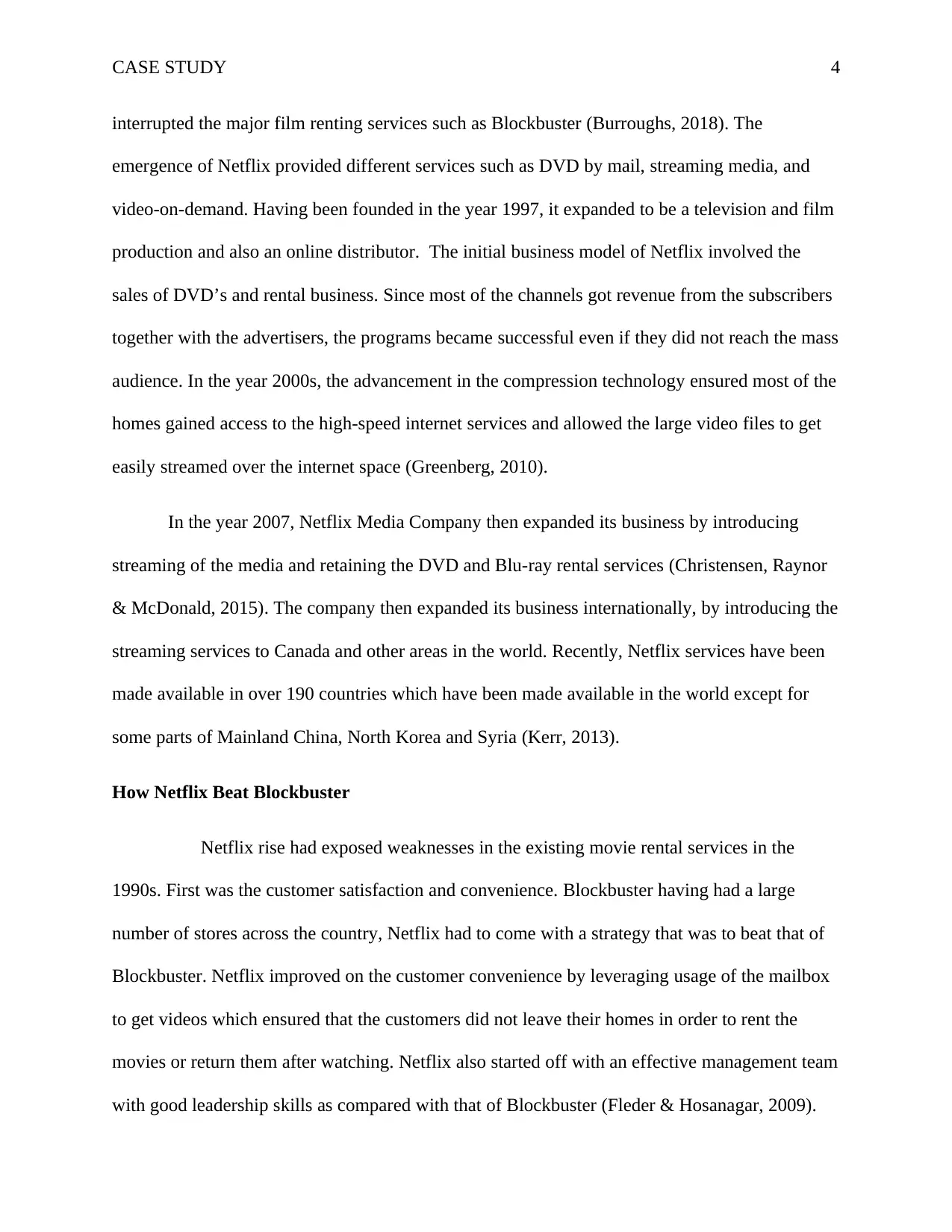
CASE STUDY 4
interrupted the major film renting services such as Blockbuster (Burroughs, 2018). The
emergence of Netflix provided different services such as DVD by mail, streaming media, and
video-on-demand. Having been founded in the year 1997, it expanded to be a television and film
production and also an online distributor. The initial business model of Netflix involved the
sales of DVD’s and rental business. Since most of the channels got revenue from the subscribers
together with the advertisers, the programs became successful even if they did not reach the mass
audience. In the year 2000s, the advancement in the compression technology ensured most of the
homes gained access to the high-speed internet services and allowed the large video files to get
easily streamed over the internet space (Greenberg, 2010).
In the year 2007, Netflix Media Company then expanded its business by introducing
streaming of the media and retaining the DVD and Blu-ray rental services (Christensen, Raynor
& McDonald, 2015). The company then expanded its business internationally, by introducing the
streaming services to Canada and other areas in the world. Recently, Netflix services have been
made available in over 190 countries which have been made available in the world except for
some parts of Mainland China, North Korea and Syria (Kerr, 2013).
How Netflix Beat Blockbuster
Netflix rise had exposed weaknesses in the existing movie rental services in the
1990s. First was the customer satisfaction and convenience. Blockbuster having had a large
number of stores across the country, Netflix had to come with a strategy that was to beat that of
Blockbuster. Netflix improved on the customer convenience by leveraging usage of the mailbox
to get videos which ensured that the customers did not leave their homes in order to rent the
movies or return them after watching. Netflix also started off with an effective management team
with good leadership skills as compared with that of Blockbuster (Fleder & Hosanagar, 2009).
interrupted the major film renting services such as Blockbuster (Burroughs, 2018). The
emergence of Netflix provided different services such as DVD by mail, streaming media, and
video-on-demand. Having been founded in the year 1997, it expanded to be a television and film
production and also an online distributor. The initial business model of Netflix involved the
sales of DVD’s and rental business. Since most of the channels got revenue from the subscribers
together with the advertisers, the programs became successful even if they did not reach the mass
audience. In the year 2000s, the advancement in the compression technology ensured most of the
homes gained access to the high-speed internet services and allowed the large video files to get
easily streamed over the internet space (Greenberg, 2010).
In the year 2007, Netflix Media Company then expanded its business by introducing
streaming of the media and retaining the DVD and Blu-ray rental services (Christensen, Raynor
& McDonald, 2015). The company then expanded its business internationally, by introducing the
streaming services to Canada and other areas in the world. Recently, Netflix services have been
made available in over 190 countries which have been made available in the world except for
some parts of Mainland China, North Korea and Syria (Kerr, 2013).
How Netflix Beat Blockbuster
Netflix rise had exposed weaknesses in the existing movie rental services in the
1990s. First was the customer satisfaction and convenience. Blockbuster having had a large
number of stores across the country, Netflix had to come with a strategy that was to beat that of
Blockbuster. Netflix improved on the customer convenience by leveraging usage of the mailbox
to get videos which ensured that the customers did not leave their homes in order to rent the
movies or return them after watching. Netflix also started off with an effective management team
with good leadership skills as compared with that of Blockbuster (Fleder & Hosanagar, 2009).
Paraphrase This Document
Need a fresh take? Get an instant paraphrase of this document with our AI Paraphraser
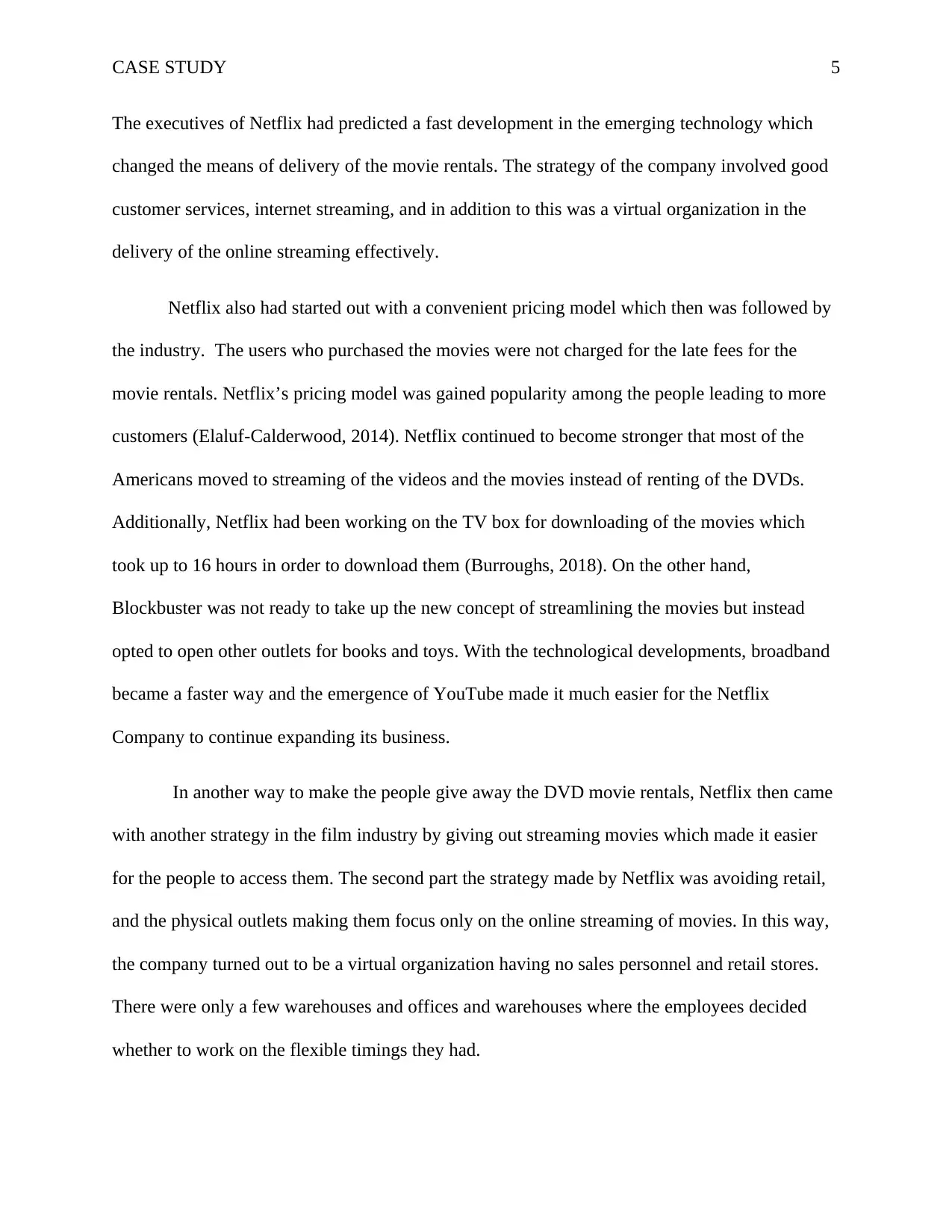
CASE STUDY 5
The executives of Netflix had predicted a fast development in the emerging technology which
changed the means of delivery of the movie rentals. The strategy of the company involved good
customer services, internet streaming, and in addition to this was a virtual organization in the
delivery of the online streaming effectively.
Netflix also had started out with a convenient pricing model which then was followed by
the industry. The users who purchased the movies were not charged for the late fees for the
movie rentals. Netflix’s pricing model was gained popularity among the people leading to more
customers (Elaluf-Calderwood, 2014). Netflix continued to become stronger that most of the
Americans moved to streaming of the videos and the movies instead of renting of the DVDs.
Additionally, Netflix had been working on the TV box for downloading of the movies which
took up to 16 hours in order to download them (Burroughs, 2018). On the other hand,
Blockbuster was not ready to take up the new concept of streamlining the movies but instead
opted to open other outlets for books and toys. With the technological developments, broadband
became a faster way and the emergence of YouTube made it much easier for the Netflix
Company to continue expanding its business.
In another way to make the people give away the DVD movie rentals, Netflix then came
with another strategy in the film industry by giving out streaming movies which made it easier
for the people to access them. The second part the strategy made by Netflix was avoiding retail,
and the physical outlets making them focus only on the online streaming of movies. In this way,
the company turned out to be a virtual organization having no sales personnel and retail stores.
There were only a few warehouses and offices and warehouses where the employees decided
whether to work on the flexible timings they had.
The executives of Netflix had predicted a fast development in the emerging technology which
changed the means of delivery of the movie rentals. The strategy of the company involved good
customer services, internet streaming, and in addition to this was a virtual organization in the
delivery of the online streaming effectively.
Netflix also had started out with a convenient pricing model which then was followed by
the industry. The users who purchased the movies were not charged for the late fees for the
movie rentals. Netflix’s pricing model was gained popularity among the people leading to more
customers (Elaluf-Calderwood, 2014). Netflix continued to become stronger that most of the
Americans moved to streaming of the videos and the movies instead of renting of the DVDs.
Additionally, Netflix had been working on the TV box for downloading of the movies which
took up to 16 hours in order to download them (Burroughs, 2018). On the other hand,
Blockbuster was not ready to take up the new concept of streamlining the movies but instead
opted to open other outlets for books and toys. With the technological developments, broadband
became a faster way and the emergence of YouTube made it much easier for the Netflix
Company to continue expanding its business.
In another way to make the people give away the DVD movie rentals, Netflix then came
with another strategy in the film industry by giving out streaming movies which made it easier
for the people to access them. The second part the strategy made by Netflix was avoiding retail,
and the physical outlets making them focus only on the online streaming of movies. In this way,
the company turned out to be a virtual organization having no sales personnel and retail stores.
There were only a few warehouses and offices and warehouses where the employees decided
whether to work on the flexible timings they had.

CASE STUDY 6
While the Netflix Company was beginning its service of DVD-by-mail which later d to
be streaming services, Blockbuster was still making money in their revenue by the use of their
model (Fleder & Hosanagar, 2009). In addition, the market margins for the new offerings from
Netflix Company did not appear to be attractive as a model which is established the model.
Blockbuster was also challenged for their technology of renting of movies was not convenient
and faster as compared to that of Netflix with the streaming technologies and the services
pertaining video-on-demand. For this reason, it hence struggled to compete against both
especially when the Netflix Company had established itself and dominated the whole of America
due to its conveniences in the offering of its services (McDonald, 2013).
Another factor which facilitated the eventual demise of the Blockbuster Company was
the implications of their business model. Pursue the new business models either streaming
services or the DVD-by-mail services requires the use of the current operating model to change
the market view (McDonald, 2013). Blockbuster needed to change their approach in the retail
stores owned by most of the people. Blockbuster, however, did not consider this option and
instead continued carrying out their services and continued to earn their profits regardless of the
strategies that had emerged from the onset of the Netflix media company (Herrington, 2015).
Failure to come up with the strategies which were to outdo the other company, Blockbuster
responded to the threats that were facing their business model when it was too late and most of
the people had shifted to Netflix which were offering best services (Dana Jr, 2017). Blockbuster
then tried eventually the DVD-by-mail service, the rental kiosks, and came up with a website
which they used for the online streaming of movies after acquiring the player.
While the Netflix Company was beginning its service of DVD-by-mail which later d to
be streaming services, Blockbuster was still making money in their revenue by the use of their
model (Fleder & Hosanagar, 2009). In addition, the market margins for the new offerings from
Netflix Company did not appear to be attractive as a model which is established the model.
Blockbuster was also challenged for their technology of renting of movies was not convenient
and faster as compared to that of Netflix with the streaming technologies and the services
pertaining video-on-demand. For this reason, it hence struggled to compete against both
especially when the Netflix Company had established itself and dominated the whole of America
due to its conveniences in the offering of its services (McDonald, 2013).
Another factor which facilitated the eventual demise of the Blockbuster Company was
the implications of their business model. Pursue the new business models either streaming
services or the DVD-by-mail services requires the use of the current operating model to change
the market view (McDonald, 2013). Blockbuster needed to change their approach in the retail
stores owned by most of the people. Blockbuster, however, did not consider this option and
instead continued carrying out their services and continued to earn their profits regardless of the
strategies that had emerged from the onset of the Netflix media company (Herrington, 2015).
Failure to come up with the strategies which were to outdo the other company, Blockbuster
responded to the threats that were facing their business model when it was too late and most of
the people had shifted to Netflix which were offering best services (Dana Jr, 2017). Blockbuster
then tried eventually the DVD-by-mail service, the rental kiosks, and came up with a website
which they used for the online streaming of movies after acquiring the player.
⊘ This is a preview!⊘
Do you want full access?
Subscribe today to unlock all pages.

Trusted by 1+ million students worldwide
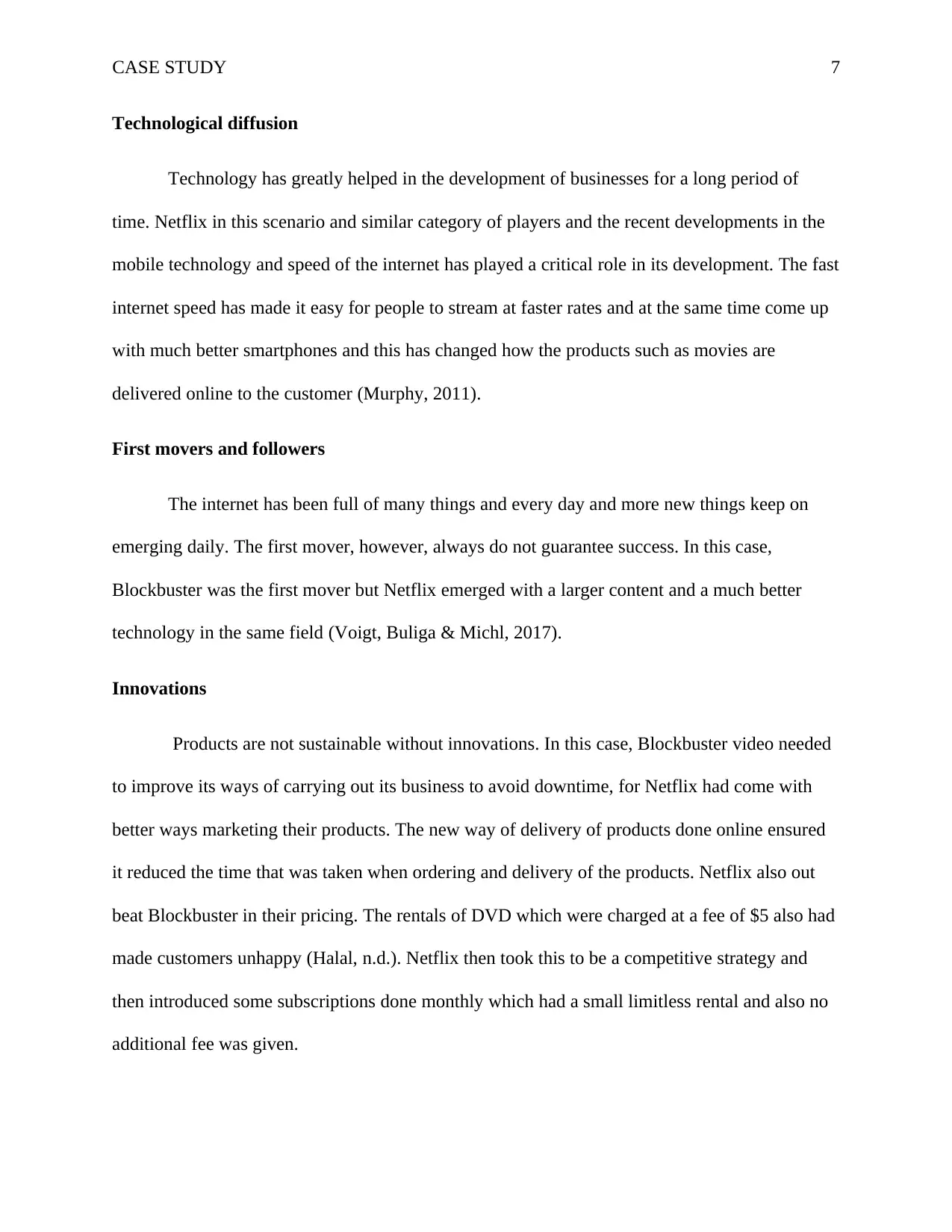
CASE STUDY 7
Technological diffusion
Technology has greatly helped in the development of businesses for a long period of
time. Netflix in this scenario and similar category of players and the recent developments in the
mobile technology and speed of the internet has played a critical role in its development. The fast
internet speed has made it easy for people to stream at faster rates and at the same time come up
with much better smartphones and this has changed how the products such as movies are
delivered online to the customer (Murphy, 2011).
First movers and followers
The internet has been full of many things and every day and more new things keep on
emerging daily. The first mover, however, always do not guarantee success. In this case,
Blockbuster was the first mover but Netflix emerged with a larger content and a much better
technology in the same field (Voigt, Buliga & Michl, 2017).
Innovations
Products are not sustainable without innovations. In this case, Blockbuster video needed
to improve its ways of carrying out its business to avoid downtime, for Netflix had come with
better ways marketing their products. The new way of delivery of products done online ensured
it reduced the time that was taken when ordering and delivery of the products. Netflix also out
beat Blockbuster in their pricing. The rentals of DVD which were charged at a fee of $5 also had
made customers unhappy (Halal, n.d.). Netflix then took this to be a competitive strategy and
then introduced some subscriptions done monthly which had a small limitless rental and also no
additional fee was given.
Technological diffusion
Technology has greatly helped in the development of businesses for a long period of
time. Netflix in this scenario and similar category of players and the recent developments in the
mobile technology and speed of the internet has played a critical role in its development. The fast
internet speed has made it easy for people to stream at faster rates and at the same time come up
with much better smartphones and this has changed how the products such as movies are
delivered online to the customer (Murphy, 2011).
First movers and followers
The internet has been full of many things and every day and more new things keep on
emerging daily. The first mover, however, always do not guarantee success. In this case,
Blockbuster was the first mover but Netflix emerged with a larger content and a much better
technology in the same field (Voigt, Buliga & Michl, 2017).
Innovations
Products are not sustainable without innovations. In this case, Blockbuster video needed
to improve its ways of carrying out its business to avoid downtime, for Netflix had come with
better ways marketing their products. The new way of delivery of products done online ensured
it reduced the time that was taken when ordering and delivery of the products. Netflix also out
beat Blockbuster in their pricing. The rentals of DVD which were charged at a fee of $5 also had
made customers unhappy (Halal, n.d.). Netflix then took this to be a competitive strategy and
then introduced some subscriptions done monthly which had a small limitless rental and also no
additional fee was given.
Paraphrase This Document
Need a fresh take? Get an instant paraphrase of this document with our AI Paraphraser
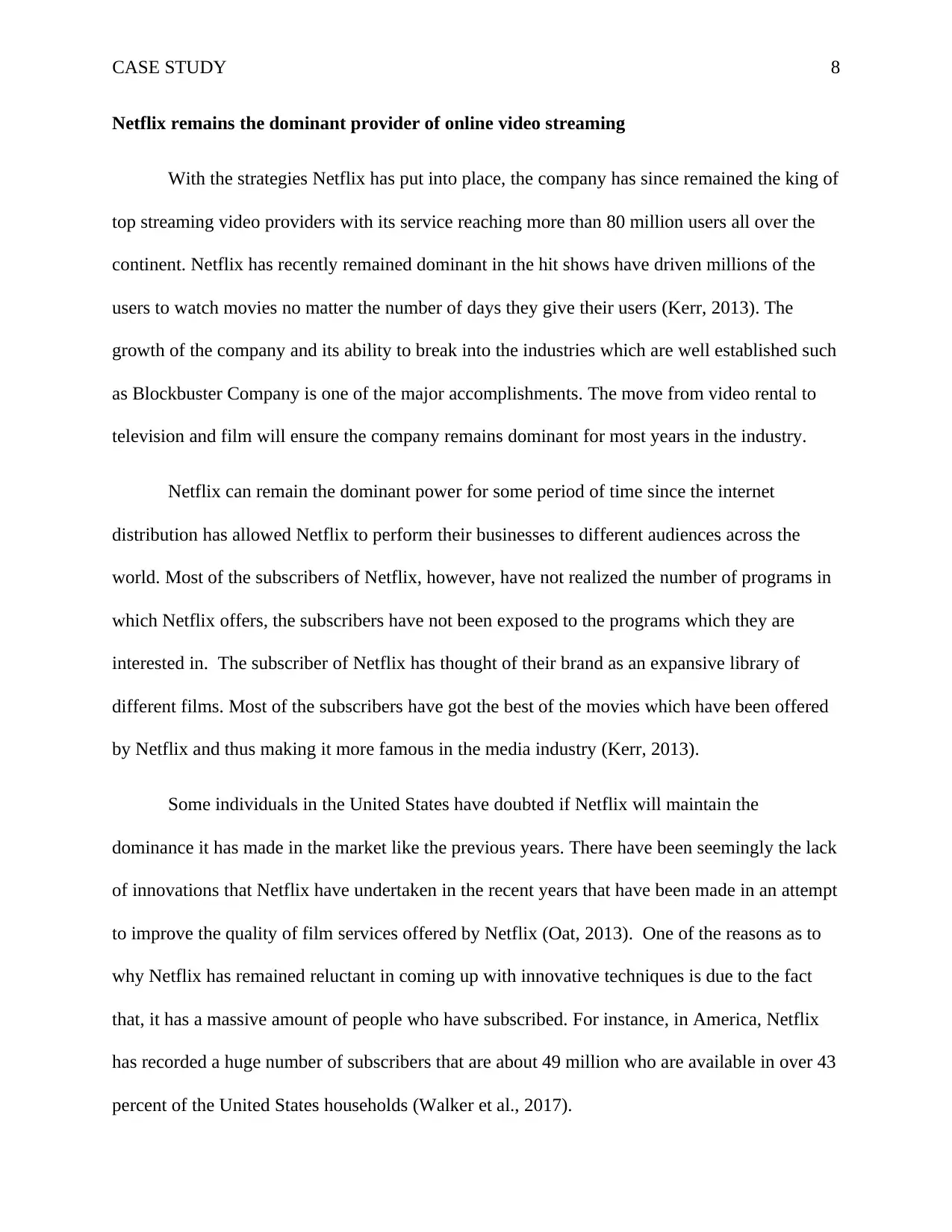
CASE STUDY 8
Netflix remains the dominant provider of online video streaming
With the strategies Netflix has put into place, the company has since remained the king of
top streaming video providers with its service reaching more than 80 million users all over the
continent. Netflix has recently remained dominant in the hit shows have driven millions of the
users to watch movies no matter the number of days they give their users (Kerr, 2013). The
growth of the company and its ability to break into the industries which are well established such
as Blockbuster Company is one of the major accomplishments. The move from video rental to
television and film will ensure the company remains dominant for most years in the industry.
Netflix can remain the dominant power for some period of time since the internet
distribution has allowed Netflix to perform their businesses to different audiences across the
world. Most of the subscribers of Netflix, however, have not realized the number of programs in
which Netflix offers, the subscribers have not been exposed to the programs which they are
interested in. The subscriber of Netflix has thought of their brand as an expansive library of
different films. Most of the subscribers have got the best of the movies which have been offered
by Netflix and thus making it more famous in the media industry (Kerr, 2013).
Some individuals in the United States have doubted if Netflix will maintain the
dominance it has made in the market like the previous years. There have been seemingly the lack
of innovations that Netflix have undertaken in the recent years that have been made in an attempt
to improve the quality of film services offered by Netflix (Oat, 2013). One of the reasons as to
why Netflix has remained reluctant in coming up with innovative techniques is due to the fact
that, it has a massive amount of people who have subscribed. For instance, in America, Netflix
has recorded a huge number of subscribers that are about 49 million who are available in over 43
percent of the United States households (Walker et al., 2017).
Netflix remains the dominant provider of online video streaming
With the strategies Netflix has put into place, the company has since remained the king of
top streaming video providers with its service reaching more than 80 million users all over the
continent. Netflix has recently remained dominant in the hit shows have driven millions of the
users to watch movies no matter the number of days they give their users (Kerr, 2013). The
growth of the company and its ability to break into the industries which are well established such
as Blockbuster Company is one of the major accomplishments. The move from video rental to
television and film will ensure the company remains dominant for most years in the industry.
Netflix can remain the dominant power for some period of time since the internet
distribution has allowed Netflix to perform their businesses to different audiences across the
world. Most of the subscribers of Netflix, however, have not realized the number of programs in
which Netflix offers, the subscribers have not been exposed to the programs which they are
interested in. The subscriber of Netflix has thought of their brand as an expansive library of
different films. Most of the subscribers have got the best of the movies which have been offered
by Netflix and thus making it more famous in the media industry (Kerr, 2013).
Some individuals in the United States have doubted if Netflix will maintain the
dominance it has made in the market like the previous years. There have been seemingly the lack
of innovations that Netflix have undertaken in the recent years that have been made in an attempt
to improve the quality of film services offered by Netflix (Oat, 2013). One of the reasons as to
why Netflix has remained reluctant in coming up with innovative techniques is due to the fact
that, it has a massive amount of people who have subscribed. For instance, in America, Netflix
has recorded a huge number of subscribers that are about 49 million who are available in over 43
percent of the United States households (Walker et al., 2017).
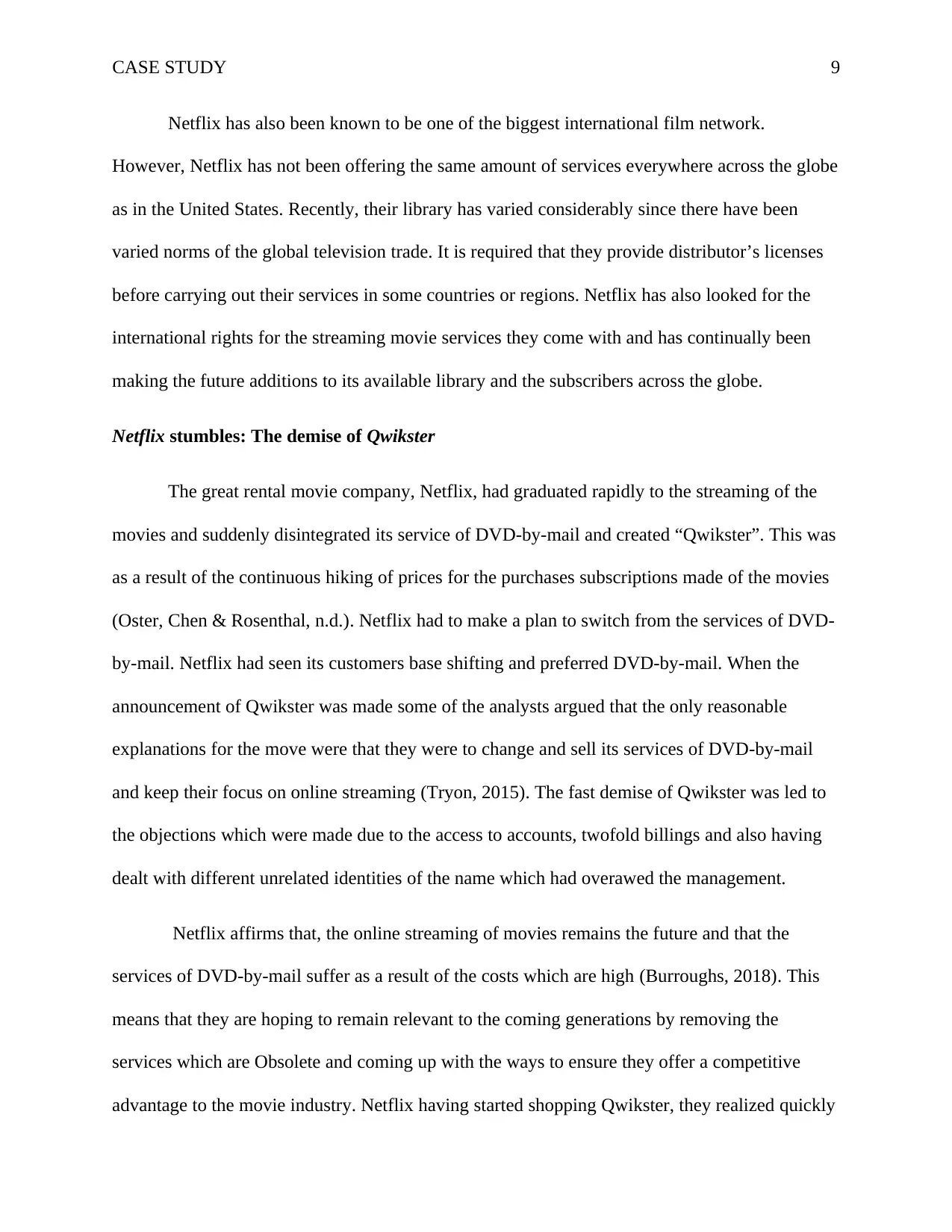
CASE STUDY 9
Netflix has also been known to be one of the biggest international film network.
However, Netflix has not been offering the same amount of services everywhere across the globe
as in the United States. Recently, their library has varied considerably since there have been
varied norms of the global television trade. It is required that they provide distributor’s licenses
before carrying out their services in some countries or regions. Netflix has also looked for the
international rights for the streaming movie services they come with and has continually been
making the future additions to its available library and the subscribers across the globe.
Netflix stumbles: The demise of Qwikster
The great rental movie company, Netflix, had graduated rapidly to the streaming of the
movies and suddenly disintegrated its service of DVD-by-mail and created “Qwikster”. This was
as a result of the continuous hiking of prices for the purchases subscriptions made of the movies
(Oster, Chen & Rosenthal, n.d.). Netflix had to make a plan to switch from the services of DVD-
by-mail. Netflix had seen its customers base shifting and preferred DVD-by-mail. When the
announcement of Qwikster was made some of the analysts argued that the only reasonable
explanations for the move were that they were to change and sell its services of DVD-by-mail
and keep their focus on online streaming (Tryon, 2015). The fast demise of Qwikster was led to
the objections which were made due to the access to accounts, twofold billings and also having
dealt with different unrelated identities of the name which had overawed the management.
Netflix affirms that, the online streaming of movies remains the future and that the
services of DVD-by-mail suffer as a result of the costs which are high (Burroughs, 2018). This
means that they are hoping to remain relevant to the coming generations by removing the
services which are Obsolete and coming up with the ways to ensure they offer a competitive
advantage to the movie industry. Netflix having started shopping Qwikster, they realized quickly
Netflix has also been known to be one of the biggest international film network.
However, Netflix has not been offering the same amount of services everywhere across the globe
as in the United States. Recently, their library has varied considerably since there have been
varied norms of the global television trade. It is required that they provide distributor’s licenses
before carrying out their services in some countries or regions. Netflix has also looked for the
international rights for the streaming movie services they come with and has continually been
making the future additions to its available library and the subscribers across the globe.
Netflix stumbles: The demise of Qwikster
The great rental movie company, Netflix, had graduated rapidly to the streaming of the
movies and suddenly disintegrated its service of DVD-by-mail and created “Qwikster”. This was
as a result of the continuous hiking of prices for the purchases subscriptions made of the movies
(Oster, Chen & Rosenthal, n.d.). Netflix had to make a plan to switch from the services of DVD-
by-mail. Netflix had seen its customers base shifting and preferred DVD-by-mail. When the
announcement of Qwikster was made some of the analysts argued that the only reasonable
explanations for the move were that they were to change and sell its services of DVD-by-mail
and keep their focus on online streaming (Tryon, 2015). The fast demise of Qwikster was led to
the objections which were made due to the access to accounts, twofold billings and also having
dealt with different unrelated identities of the name which had overawed the management.
Netflix affirms that, the online streaming of movies remains the future and that the
services of DVD-by-mail suffer as a result of the costs which are high (Burroughs, 2018). This
means that they are hoping to remain relevant to the coming generations by removing the
services which are Obsolete and coming up with the ways to ensure they offer a competitive
advantage to the movie industry. Netflix having started shopping Qwikster, they realized quickly
⊘ This is a preview!⊘
Do you want full access?
Subscribe today to unlock all pages.

Trusted by 1+ million students worldwide
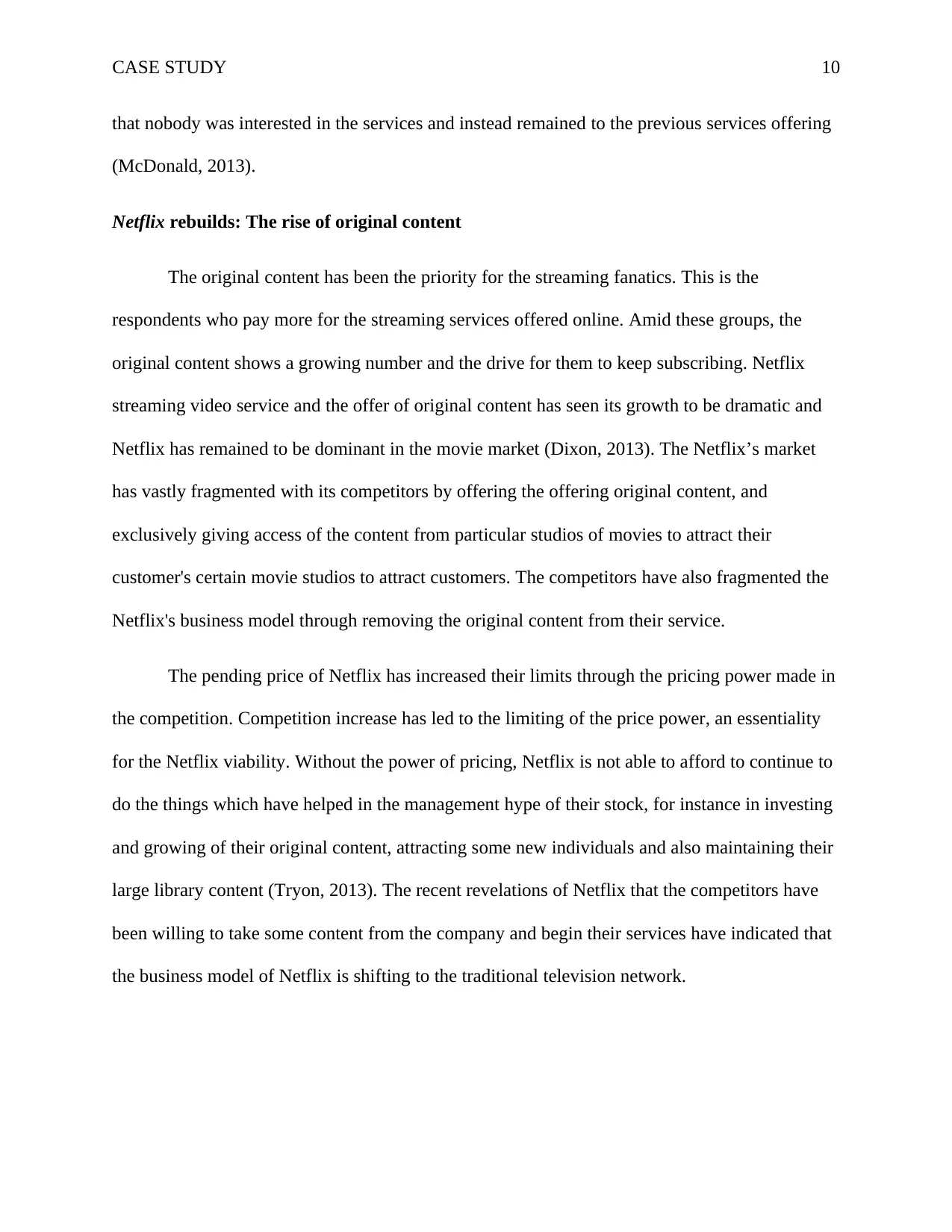
CASE STUDY 10
that nobody was interested in the services and instead remained to the previous services offering
(McDonald, 2013).
Netflix rebuilds: The rise of original content
The original content has been the priority for the streaming fanatics. This is the
respondents who pay more for the streaming services offered online. Amid these groups, the
original content shows a growing number and the drive for them to keep subscribing. Netflix
streaming video service and the offer of original content has seen its growth to be dramatic and
Netflix has remained to be dominant in the movie market (Dixon, 2013). The Netflix’s market
has vastly fragmented with its competitors by offering the offering original content, and
exclusively giving access of the content from particular studios of movies to attract their
customer's certain movie studios to attract customers. The competitors have also fragmented the
Netflix's business model through removing the original content from their service.
The pending price of Netflix has increased their limits through the pricing power made in
the competition. Competition increase has led to the limiting of the price power, an essentiality
for the Netflix viability. Without the power of pricing, Netflix is not able to afford to continue to
do the things which have helped in the management hype of their stock, for instance in investing
and growing of their original content, attracting some new individuals and also maintaining their
large library content (Tryon, 2013). The recent revelations of Netflix that the competitors have
been willing to take some content from the company and begin their services have indicated that
the business model of Netflix is shifting to the traditional television network.
that nobody was interested in the services and instead remained to the previous services offering
(McDonald, 2013).
Netflix rebuilds: The rise of original content
The original content has been the priority for the streaming fanatics. This is the
respondents who pay more for the streaming services offered online. Amid these groups, the
original content shows a growing number and the drive for them to keep subscribing. Netflix
streaming video service and the offer of original content has seen its growth to be dramatic and
Netflix has remained to be dominant in the movie market (Dixon, 2013). The Netflix’s market
has vastly fragmented with its competitors by offering the offering original content, and
exclusively giving access of the content from particular studios of movies to attract their
customer's certain movie studios to attract customers. The competitors have also fragmented the
Netflix's business model through removing the original content from their service.
The pending price of Netflix has increased their limits through the pricing power made in
the competition. Competition increase has led to the limiting of the price power, an essentiality
for the Netflix viability. Without the power of pricing, Netflix is not able to afford to continue to
do the things which have helped in the management hype of their stock, for instance in investing
and growing of their original content, attracting some new individuals and also maintaining their
large library content (Tryon, 2013). The recent revelations of Netflix that the competitors have
been willing to take some content from the company and begin their services have indicated that
the business model of Netflix is shifting to the traditional television network.
Paraphrase This Document
Need a fresh take? Get an instant paraphrase of this document with our AI Paraphraser
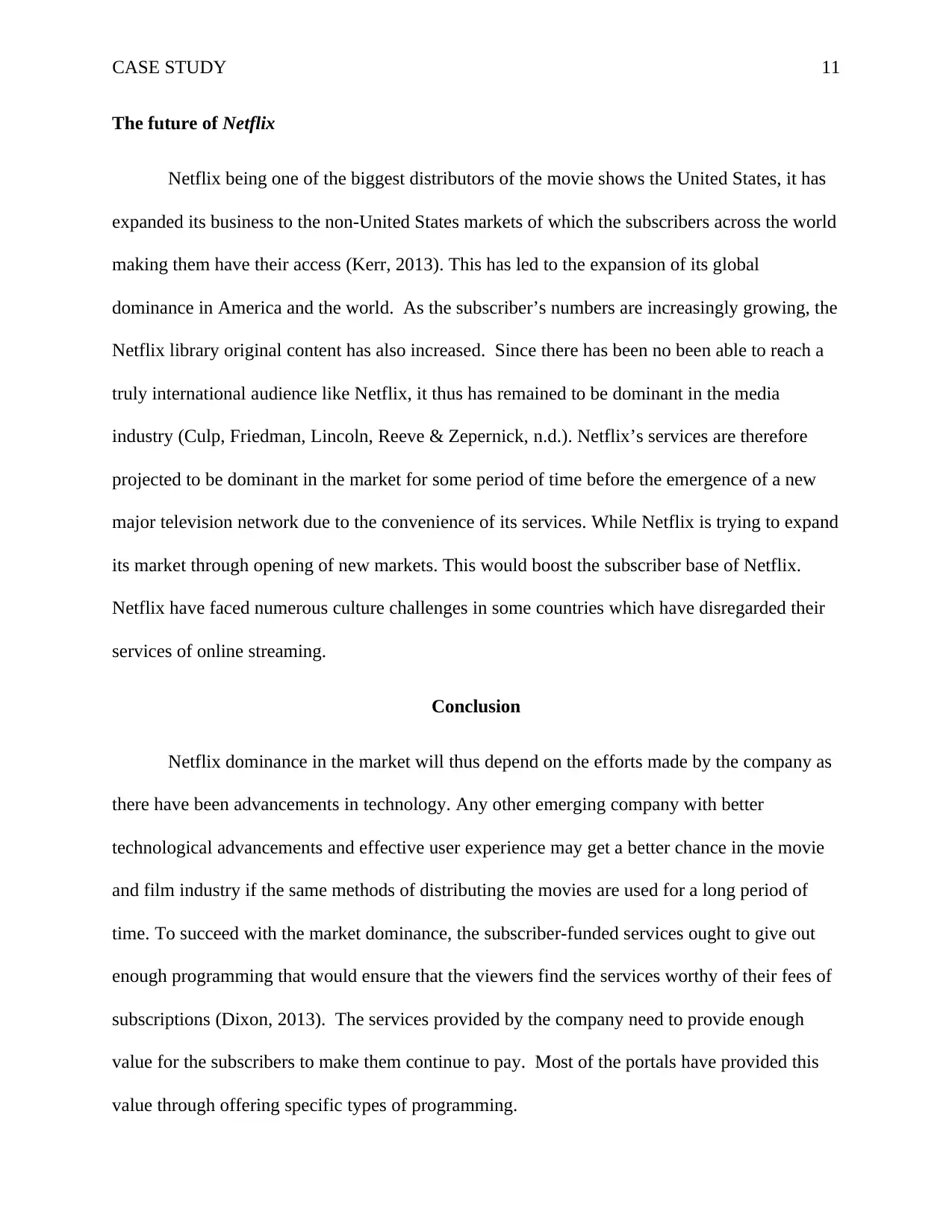
CASE STUDY 11
The future of Netflix
Netflix being one of the biggest distributors of the movie shows the United States, it has
expanded its business to the non-United States markets of which the subscribers across the world
making them have their access (Kerr, 2013). This has led to the expansion of its global
dominance in America and the world. As the subscriber’s numbers are increasingly growing, the
Netflix library original content has also increased. Since there has been no been able to reach a
truly international audience like Netflix, it thus has remained to be dominant in the media
industry (Culp, Friedman, Lincoln, Reeve & Zepernick, n.d.). Netflix’s services are therefore
projected to be dominant in the market for some period of time before the emergence of a new
major television network due to the convenience of its services. While Netflix is trying to expand
its market through opening of new markets. This would boost the subscriber base of Netflix.
Netflix have faced numerous culture challenges in some countries which have disregarded their
services of online streaming.
Conclusion
Netflix dominance in the market will thus depend on the efforts made by the company as
there have been advancements in technology. Any other emerging company with better
technological advancements and effective user experience may get a better chance in the movie
and film industry if the same methods of distributing the movies are used for a long period of
time. To succeed with the market dominance, the subscriber-funded services ought to give out
enough programming that would ensure that the viewers find the services worthy of their fees of
subscriptions (Dixon, 2013). The services provided by the company need to provide enough
value for the subscribers to make them continue to pay. Most of the portals have provided this
value through offering specific types of programming.
The future of Netflix
Netflix being one of the biggest distributors of the movie shows the United States, it has
expanded its business to the non-United States markets of which the subscribers across the world
making them have their access (Kerr, 2013). This has led to the expansion of its global
dominance in America and the world. As the subscriber’s numbers are increasingly growing, the
Netflix library original content has also increased. Since there has been no been able to reach a
truly international audience like Netflix, it thus has remained to be dominant in the media
industry (Culp, Friedman, Lincoln, Reeve & Zepernick, n.d.). Netflix’s services are therefore
projected to be dominant in the market for some period of time before the emergence of a new
major television network due to the convenience of its services. While Netflix is trying to expand
its market through opening of new markets. This would boost the subscriber base of Netflix.
Netflix have faced numerous culture challenges in some countries which have disregarded their
services of online streaming.
Conclusion
Netflix dominance in the market will thus depend on the efforts made by the company as
there have been advancements in technology. Any other emerging company with better
technological advancements and effective user experience may get a better chance in the movie
and film industry if the same methods of distributing the movies are used for a long period of
time. To succeed with the market dominance, the subscriber-funded services ought to give out
enough programming that would ensure that the viewers find the services worthy of their fees of
subscriptions (Dixon, 2013). The services provided by the company need to provide enough
value for the subscribers to make them continue to pay. Most of the portals have provided this
value through offering specific types of programming.
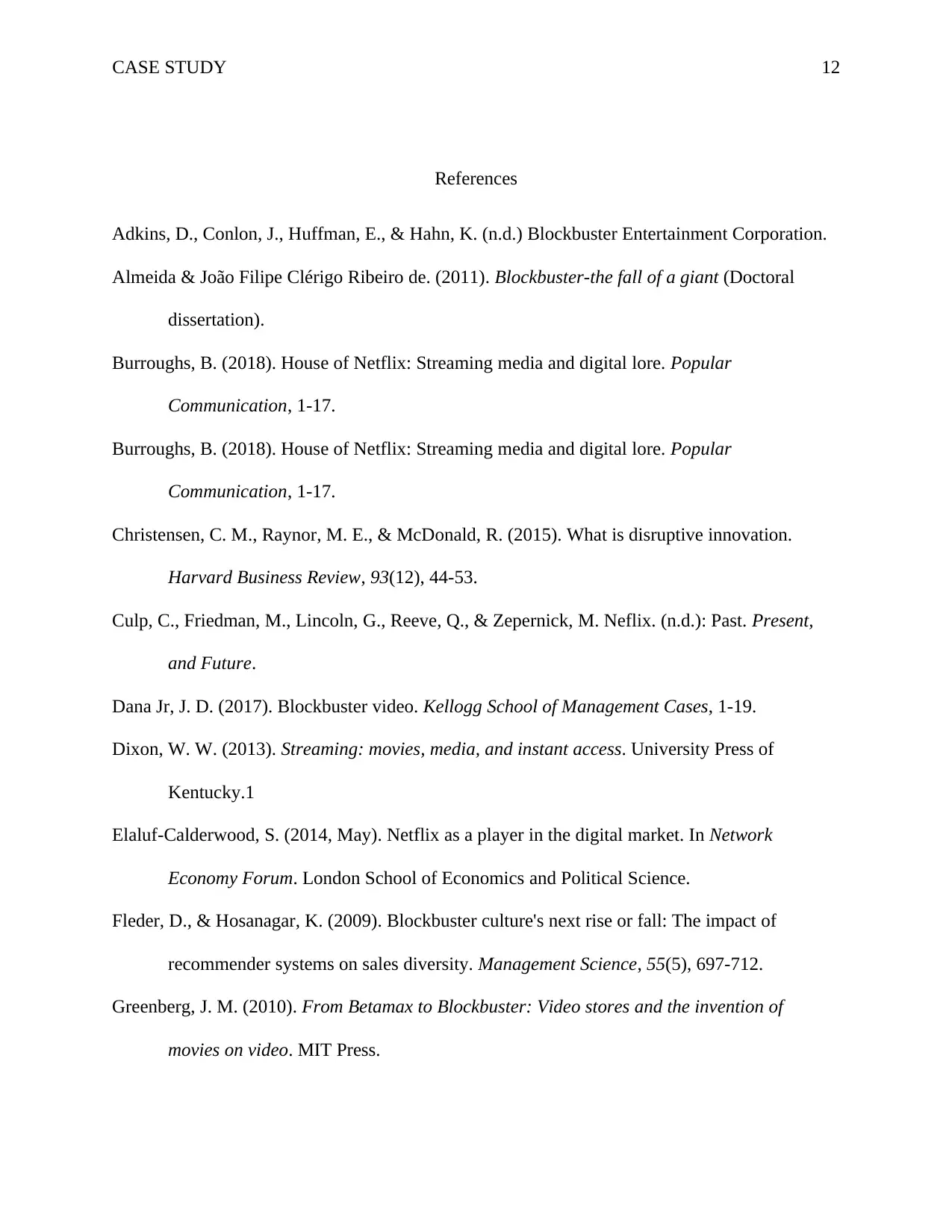
CASE STUDY 12
References
Adkins, D., Conlon, J., Huffman, E., & Hahn, K. (n.d.) Blockbuster Entertainment Corporation.
Almeida & João Filipe Clérigo Ribeiro de. (2011). Blockbuster-the fall of a giant (Doctoral
dissertation).
Burroughs, B. (2018). House of Netflix: Streaming media and digital lore. Popular
Communication, 1-17.
Burroughs, B. (2018). House of Netflix: Streaming media and digital lore. Popular
Communication, 1-17.
Christensen, C. M., Raynor, M. E., & McDonald, R. (2015). What is disruptive innovation.
Harvard Business Review, 93(12), 44-53.
Culp, C., Friedman, M., Lincoln, G., Reeve, Q., & Zepernick, M. Neflix. (n.d.): Past. Present,
and Future.
Dana Jr, J. D. (2017). Blockbuster video. Kellogg School of Management Cases, 1-19.
Dixon, W. W. (2013). Streaming: movies, media, and instant access. University Press of
Kentucky.1
Elaluf-Calderwood, S. (2014, May). Netflix as a player in the digital market. In Network
Economy Forum. London School of Economics and Political Science.
Fleder, D., & Hosanagar, K. (2009). Blockbuster culture's next rise or fall: The impact of
recommender systems on sales diversity. Management Science, 55(5), 697-712.
Greenberg, J. M. (2010). From Betamax to Blockbuster: Video stores and the invention of
movies on video. MIT Press.
References
Adkins, D., Conlon, J., Huffman, E., & Hahn, K. (n.d.) Blockbuster Entertainment Corporation.
Almeida & João Filipe Clérigo Ribeiro de. (2011). Blockbuster-the fall of a giant (Doctoral
dissertation).
Burroughs, B. (2018). House of Netflix: Streaming media and digital lore. Popular
Communication, 1-17.
Burroughs, B. (2018). House of Netflix: Streaming media and digital lore. Popular
Communication, 1-17.
Christensen, C. M., Raynor, M. E., & McDonald, R. (2015). What is disruptive innovation.
Harvard Business Review, 93(12), 44-53.
Culp, C., Friedman, M., Lincoln, G., Reeve, Q., & Zepernick, M. Neflix. (n.d.): Past. Present,
and Future.
Dana Jr, J. D. (2017). Blockbuster video. Kellogg School of Management Cases, 1-19.
Dixon, W. W. (2013). Streaming: movies, media, and instant access. University Press of
Kentucky.1
Elaluf-Calderwood, S. (2014, May). Netflix as a player in the digital market. In Network
Economy Forum. London School of Economics and Political Science.
Fleder, D., & Hosanagar, K. (2009). Blockbuster culture's next rise or fall: The impact of
recommender systems on sales diversity. Management Science, 55(5), 697-712.
Greenberg, J. M. (2010). From Betamax to Blockbuster: Video stores and the invention of
movies on video. MIT Press.
⊘ This is a preview!⊘
Do you want full access?
Subscribe today to unlock all pages.

Trusted by 1+ million students worldwide
1 out of 14
Related Documents
Your All-in-One AI-Powered Toolkit for Academic Success.
+13062052269
info@desklib.com
Available 24*7 on WhatsApp / Email
![[object Object]](/_next/static/media/star-bottom.7253800d.svg)
Unlock your academic potential
Copyright © 2020–2025 A2Z Services. All Rights Reserved. Developed and managed by ZUCOL.




